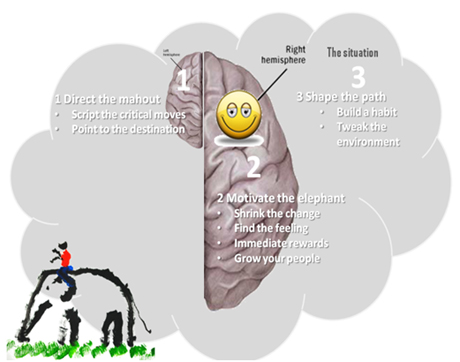By: Bengt Järrehult
In trying to understand why we act in a predictably irrational ways, for example choosing short-term instead of long-term rewards, Bengt Järrehult uses the metaphor of the mahout and elephant to depict the different parts of the human brain and it’s processes. In an innovation effort, how can you direct the mahout and motivate the elephant?
In my earlier blog I wrote about the eternal fight between urgent and important. I will dwell more on the topic and this time refer to the May 2012 issue of Harvard Business Review, where the main article was Managing your Innovation Portfolio by Bansi Nagi and Geoff Tuff. They showed that the optimum balance for long term profit was to have a ratio between Core activities (i.e. Incremental Innovation, Adjacent Activities and finally Transformational Activities, i.e. Breakthrough Innovation) of 10:20:70. Instead we focus on short term profit where optimum ratio is the reverse 70:20:10. Why is it often so hard for someone to act in a way that favors long term rewards and instead he/she mainly chooses short term rewards instead? It does not seem logical…why is he/she irrational? I got help to solve this issue from the book Switch by the brothers Chip & Dan Heath.
In trying to understand why we act in a predictably irrational way, we can use simplifying metaphors depicting different parts of our brain. Here a mahout (=elephant driver) is the metaphor for the reflective system of the brain, what we used to call the left and logical part of the brain (although we now know that this system involves several parts of the brain, not only those in the left part – we keep this somewhat erroneous simplification. It is easier to comprehend than Nobel Laureate Daniel Kahneman’s System 1 and 2 in his book Thinking Fast and Slow). The elephant then is the metaphor for the right and automatic system of the brain, what we use to call the emotional brain part. The jungle path then symbolizes the environment/situation we are in.

The mahout is the logical planner but the elephant has the main energy and strength and is the real doer. The weakness of the elephant is short term thinking and following the easy road – whereas the mahout can work for a long while waiting for a big reward later, the elephant needs immediate rewards….NOW. Looking at the brain where the left part is small in terms of real power in comparison with the right part helps us to understand why sometimes it is so hard to persist in doing something that we logically know is right, but so hard to keep on doing over time. Here some tricks to succeed:
For the “left brain” – make simple directions for the mahout
- Find the bright spots/script the critical moves: the first most obvious thing to do in innovation I believe is to induce a failure friendly culture. Celebrate failures and especially celebrate those that have been so cheap that you can do some more failures before you have your inevitable success in the end.
- Point to the destination. In this case it would be to depict the vision where we specifically will be in a specific future (set a precise date, e.g. 2017, June 16th ).
For the “right brain” – motivate the elephant extrinsically and intrinsically
- Shrink the change: In order to lead the elephant in the right direction you should look at what is innovative already today and that we can build on. Do not scare people and scold we are so lousy at innovation – that will not help.
- Find the feeling: make this joyful and pleasant and fun to do.
- Immediate rewards: try to find ways to reward the people that are on the right path. Please note though that “Now that…”-rewards work a lot better than “If…then…”-rewards. Money is the least cost efficient motivator that exists.
- Grow your people: show success cases as soon as they occur and tap the shoulders of these role models publicly.
For the situation – shape the jungle path to make walking it easier
- Build a habit: find operating procedures that facilitate for the staff to act in certain ways.
- Tweak the environment: find tools that facilitate achievement of what you want , e.g. hot houses or incubators that shall focus on Breakthrough Innovation.
- Rally the herd: make the snowball effect possible in that people automatically align into what we believe is innovative behavior. Find role model behaviors and publicly reward them.
For change to happen that promotes innovation it is wiser to address the right brain than the left. Use “see-feel-change” instead of “analyze-think-change.”
By Bengt Järrehult
» Download a PowerPoint Presentation for this blog!
About the author
 Bengt Järrehult is Fellow Scientist Innovation at SCA, a global hygiene products and paper company. He is also adjunct professor and visiting professor resp. at 2 departments of Lund University in Sweden. He is an avid reader of and presenter on the topics of innovation, especially on breakthrough innovation and the psychological hurdles that exist to achieve this, hurdles that we may or may not be aware of. He is of the opinion that most companies more or less know what to do to become more innovative. What they don’t know is what really hinders them from doing these measures…
Bengt Järrehult is Fellow Scientist Innovation at SCA, a global hygiene products and paper company. He is also adjunct professor and visiting professor resp. at 2 departments of Lund University in Sweden. He is an avid reader of and presenter on the topics of innovation, especially on breakthrough innovation and the psychological hurdles that exist to achieve this, hurdles that we may or may not be aware of. He is of the opinion that most companies more or less know what to do to become more innovative. What they don’t know is what really hinders them from doing these measures…
